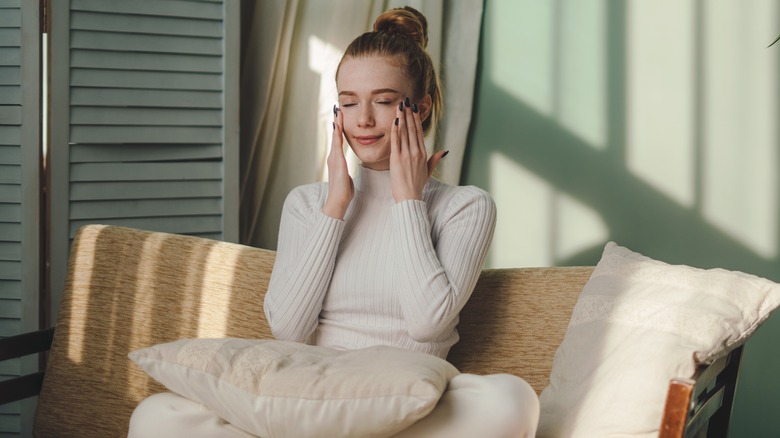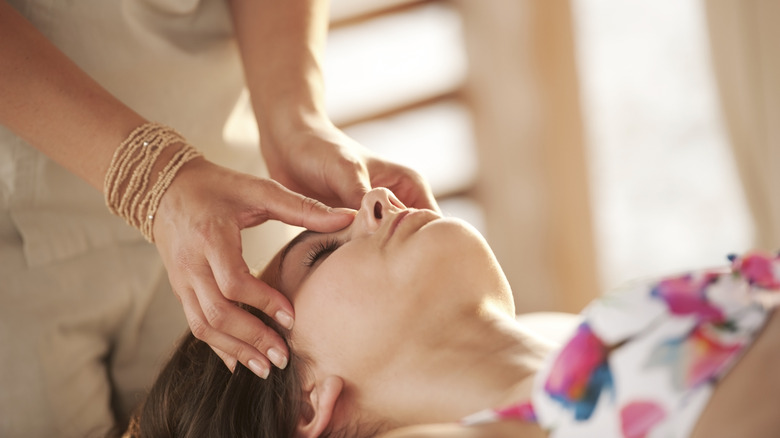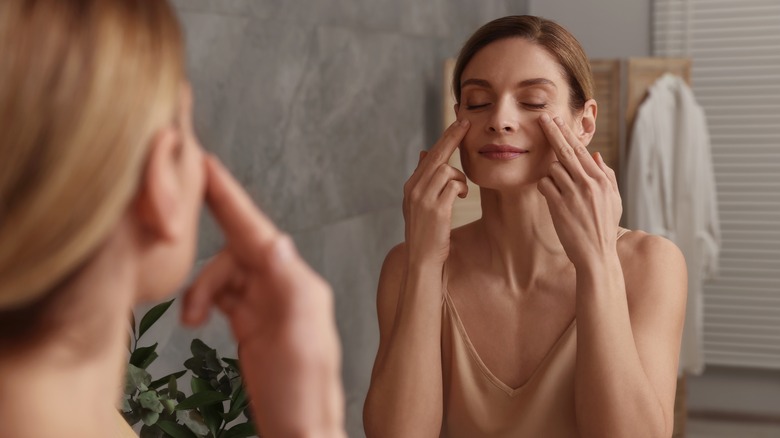What Is Bone Tapping And What Can It Do For Your Skin? We Asked An Esthetician
Traditional Chinese medicine (TCM) practices, such as acupuncture and cupping, have long been used to treat certain health conditions and maintain overall well-being. However, many people also take up these alternative healing techniques to maintain clear and youthful skin. For instance, cosmetic acupuncture, gua sha massages, and facial cupping are all popular TCM practices that estheticians have adapted to address common beauty concerns, including acne, wrinkles, and dullness. Another exciting wellness practice to join the mix is bone tapping.
To learn more about this, Glam spoke to Gregory Dylan, a licensed esthetician of 25 years and the owner of Gregory Dylan Skincare. "Bone tapping is a technique where the fingertips are used to gently tap along the bone structure of the face with light to medium pressure in an effort to reduce the appearance of fine lines and wrinkles, smooth texture, and increase radiance," Dylan tells Glam during an exclusive interview. According to Dylan, " ... this practice has trickled into modern esthetics in the different styles of facial massage used by estheticians, more commonly referred to as tapotement." As such, Dylan reveals that bone-tapping massages not only help you relax but also promote healthy and radiant skin.
How does it work?
Bone tapping falls under the same category as acupuncture and acupressure. However, unlike acupuncture — which involves needles — acupressure and bone tapping rely on manual massage therapy and TCM pressure points to "clear energy blockages in the body," Gregory Dylan shares exclusively with Glam.
"Tapping the skin will increase blood flow, helping to bring extra oxygen and nutrients that help to not only repair the skin but provide extra glow to the complexion," Dylan reveals. "It may also aid in firming the skin and eliminating toxins," he adds. This aligns with the basics of lymphatic drainage. Applying gentle pressure around your eyes and forehead encourages the movement of stagnant lymph fluid to decrease puffiness due to fluid build-up.
"Additionally, tapping has been shown to help the user feel increased sensations of calm and relaxation, which is always beneficial in our overly busy lives," Dylan says. In other words, you can use specific pressure points to improve your well-being by combining bone tapping with acupressure. For instance, targeting pressure points along the forehead, temples, and ears can help you reduce anxiety, muscle tension, and migraines.
Tips for performing bone tapping at home
During an exclusive chat with Glam, licensed esthetician Gregory Dylan shared his expert advice on how to go about adopting your own at-home bone tapping routine. While you'll likely find an endless collection of YouTube and TikTok tutorials online, Dylan highlights three key areas of the face to hone in on. "You'll want to use light to medium pressure with your fingertips and tap along the forehead, cheekbones, and jawline," he explains.
Moreover, Dylan recommends you begin by washing your hands to prevent the spread of dirt and bacteria to your face. Similarly, ensure you have a clean base by gently cleansing your skin. He also suggests using an oil to reduce friction or a face serum, in which case "the tapping will help to increase the penetration of the product."
To address multiple skin or health concerns, pinpoint the pressure points along your face according to a Chinese medicine chart and focus on these areas the most. The goal is to remain consistent with your bone tapping regimen until you observe results. Bone tapping is one of the rare beauty secrets that has zero downtime and costs nothing, so there's no harm in adding this ancient beauty method to your daily routine.


